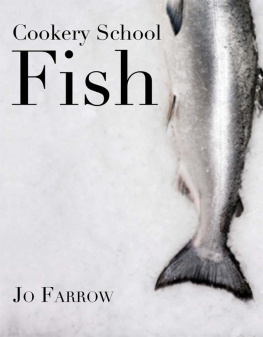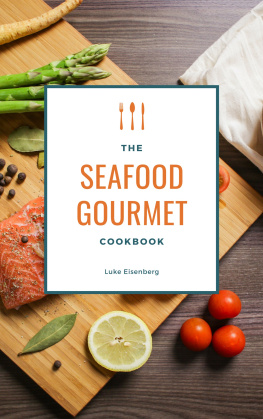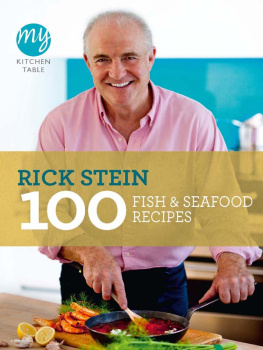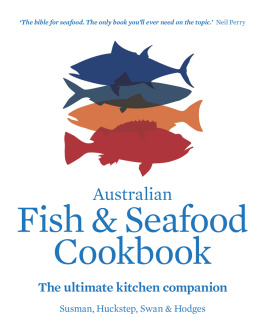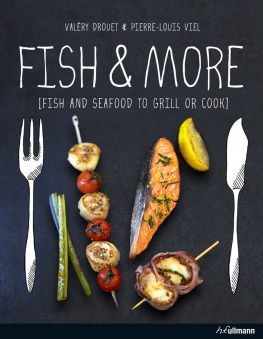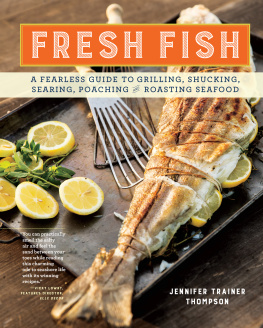ACKNOWLEDGMENTS
So many generous people helped me research and write this book, sharing their invaluable experience, tips, and titbits. My special thanks to Samuel DAngelo, owner of Samuels and Son Seafood, who acted as industry advisor for the book, allowing us access to Samuels amongst all the busy work of receiving, processing, packing, and shipping that goes on every day. Joe Lasprogata, the companys director of purchasing, worked closely with us to produce the techniques in the book, making sure that we had all the beautiful product we needed, whether geoduck from the Pacific Northwest, rouget from the Mediterranean, or crawfish from Louisiana, even when we showed up on the busiest week of the yearjust before Mothers Day! Thanks to Anthony DAngelo for showing me the best way to prepare abalone. Thanks to our expert cutters at Samuels: Pham Mung and Hang Nguyen. Many thanks to Ameen Lawrence, proud and skillful oyster shucker at The Oyster House.
Of course, none of this would have happened without the cheerful and careful work of the books editor, Rochelle Bourgault. Weve had a lot of fun and groans snagging sea-puns and sayingsthat list is growing longer every day! Many thanks to Clare Pelino, of ProLiterary Agency, for finding Quarry Books. And, thanks to Steve Legato, who takes the most beautiful food photographs with many dashes of offbeat humor.
Thanks to everyone I interviewed and everyone else I spoke to who helped me understand the incredibly complex seafood back story. Thanks to Jemma McCowen, of Cleanseas, for the great contacts through her network of international seafood experts. Thanks to Hayley MatsonMathes, co-author of the Hawaii Farmers Market Cookbook, for connecting me with Brooks Takenaka of United Fishing Agency, Honolulu. Thanks to Helene York, Director of Strategic Initiatives, Bon Appetit Management Company, for explaining what her company is doing to further seafood sustainability. Thanks to Paul Balthrop, Florida Department of Agriculture, Bureau of Seafood and Aquaculture Marketing, for teaching me about Florida seafood.
Special thanks to everyone who contributed recipes: Michael Tuohy, chef of Grange Restaurant, Sacramento, Braiden Rex-Johnson, Seattle food writer, Cesare Casella of Salumeria Rosi, chef-author Zarela Martinez, New York City, Sam Mink of the Oyster House, Philadelphia, Moon Krapugthong of Mango Moon Restaurant, Philadelphia, Maggie Beer of Maggie Beer, South Australian cook, author, restaurateur and food manufacturer, Janet Amateau of Restaurant Tradescantia, near Barcelona, Philip Sinclair of Sooke Harbour House on Vancouver Island, Sandy Nguyen of Coastal Communities Consulting in New Orleans, Amy Riolo, chef and consultant in Washington, DC, Velia de Angelia of Velias Cooking Style, Umbria, Italy, Chef David Anderson of Portola Restaurant & Caf at the Monterey Bay Aquarium, and Aglaia Kremezi of Kea Artisanale, Kea, Greece.
ABOUT THE AUTHOR

Aliza Green, author, journalist, and influential chef, has been a fish lover her whole life. A lifetime of seafood memories include alderwood planked wild salmon on Blake Island near Seattle, Washington, paella studded with bite-size octopus at Los Caracoles in Barcelona, Spain, and fresh-caught rouget (red mullet) cooked over a wild fennelwood fire on the island of Corsica. She is the author of ten successful cookbooks on subjects ranging from beans to baking. The Fishmongers Apprentice is her third book about seafood. Green won the coveted James Beard award for coauthoring Ceviche!: Seafood, Salads, and Cocktails With a Latino Twist (Running Press, 2001) with chef Guillermo Pernot. Her Field Guide to Seafood (Quirk Books, 2007) is a compact encyclopedia of fish written from the cooks point of view that is a must at top restaurants and seafood markets.
To learn more about Green or to ask a culinary question, visit her website, www.alizagreen.com .
JAY SILVER:
RETAIL FISHMONGER FOR EIGHTEEN YEARS
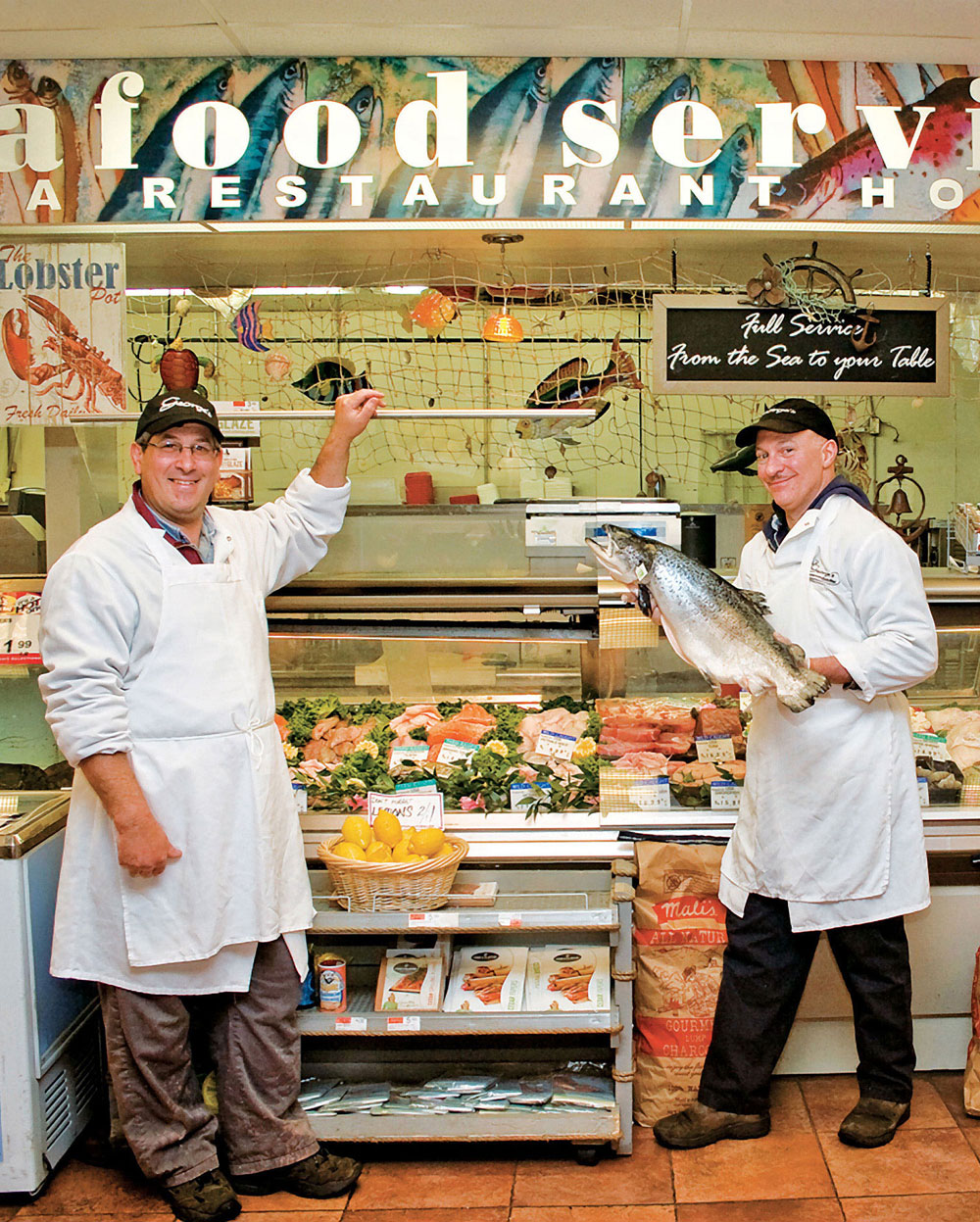
Fishmongers Jay Silver and Frank Tornetta at their retail fish counter
A CONSUMMATE FISHMONGER WHO KNOWS HIS CUSTOMERS ALMOST AS WELL AS HE KNOWS HIS FISH, JAY SILVER WORKS IN TANDEM WITH FRANK TORNETTA, WHO IS EQUALLY KNOWLEDGEABLE. BETWEEN SILVERS JEWISH BACKGROUND AND TORNETTAS ITALIAN BACKGROUND, THEY COVER THE WATERFRONT OF THEIR CUSTOMER BASE.
They know who will be looking for what and when: carp, whitefish, and pike for gefilte fish at Passover and at Rosh Hashanah, and eels and bacala (salt-cod) at Christmas for the Feast of the Seven Fishes (La Vigilia) on Christmas Eve.
Silver didnt grow up in the fish business, although it was a typically Jewish business for generations. However, he is the son of a kosher butcher so, he says, food is in my blood. Silver moved to the California Bay Area after high school and worked in numerous restaurants as a cook, which was his introduction to different kinds of fish and ways to use them. He later worked at Whole Foods in Berkeley, California, as a meat and seafood team member, which was his first taste of retail. He moved back East and began working at Georges Dreshertown Shop n Bag in Philadelphia as the seafood department manager in 1991. Silver also teaches courses about seafood.
At this smallish though busy and extremely well-stocked market, the two fishmongers hold court every day for happy fish buyers.
We have a pretty good idea of what our customers want. The first thing they ask us is, Whats fresh today?
WHY DO CUSTOMERS CHOOSE YOUR STORE?
Basically, we make it easy for them. We peel their shrimp, we cook the shrimp, we skin their fish, we walk them through our products. The two of us [Jay Silver and Frank Tornetta run the department] eat fish every day. Frank takes fish to his father; I take fish every day to my father and his girlfriend. We stand behind the counter here every day. Its Georges name on the banner [Georges Dreshertown Shop n Bag], but the customer doesnt know George; they know us. If something goes wrong, theyre going to yell at us. Frank and I have each been working here for eighteen years so we have a pretty good idea of what our customers want. The first thing they ask us is, Whats fresh today?
WHAT KIND OF SHELLFISH DO YOU SELL?
Our shrimp have no preservatives. Theyre just packed in saltwaterwe make sure of that. Our Ocean Garden brand white Pacific shrimp from Mexico are top quality and we only carry untreated scallops. One day, a woman told me that she can buy scallops [elsewhere] at a much lower price. I answered, Those scallops are treated [with TSP, trisodium phosphate) and have a totally different flavor. She said, No, a scallop is a scallop is a scallop! So, I gave her two of our natural scallops and asked her to let me know how it cooks up. She returned and admitted, There really is a difference.
HOW ABOUT FARMED FISHWHAT DO YOU SELL?
We carry conventional and organic Black Pearl salmon, which comes from the Shetland Islands and northern Scotland. As far as tilapia, if its not fresh, we dont carry it. We did a taste test because tilapia can be dusty-tasting and decided on a sustainably raised brand from Costa Rica whose product contains no additives, preservatives, or growth enhancers.
HOW DIVERSE IS YOUR CLIENTELE?
We have a pretty big Jewish clientele who are very vocal about finding kosher fish [with fins and scales]. I dont make gefilte fish from scratch here, but I do grind fish for our customers. Ill grind carp, Ill grind whitefish. Ill clean it out, Ill chop the heads, Ill clean all the bones out. I take the eyes out, I scale it, I do all of that. So you have all the bones [to make the jellied stock], that I put it in a little separate bag. The Italians come at Christmasthe same people every year. We get the whiting, we get in the octopus, we do the seven fishes [that many Italians serve on Christmas Eve]. We get in the anchovies, sardines, calamari. We sold over 100 pounds (45.4 kg) of squid last Christmas. We even bring in eels, but not live. We have Asian customers and also some island people who might want the head of a fish.


